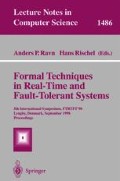Abstract
As most, if not all, real-time software is also critical, it is not unreasonable to expect developers to use best practice in the production of real-time software. But what is best practice? In terms of development, it would not be unreasonable to expect the use of structured analysis and design methods. In terms of verification of safety/liveness properties, it is not unreasonable to expect the use of a formalism. In general, however, structured methods and formal methods have different ways of modeling a system, so how can we be sure that properties that are proven of a formal model hold for a structured design? The answer is method integration. Method integration is a term commonly used to refer to the combination of a structured analysis or design method with a formal method. In this paper we shall present work on the integration of the structured real-time design method HRT-HOOD, and the real-time formal method Modecharts. We shall discuss the deficiencies of each of the methods, and show that when used together they co-optimize, enabling the user to produce a structured design that is amenable to scheduling analysis, which can also have properties about it verified.
Partly funded by a CASE award from the European Space Agency.
Preview
Unable to display preview. Download preview PDF.
References
A. Burns and A.J. Wellings. HRT-HOOD: A structured design method for hard real-time Ada systems, volume 3 of Real-Time Safty Critical Systems. Elsevier, 1995.
D. Harel. Statecharts: A visual formalism for complex systems. Science of computer programming, 8(3):231–274, 1987.
Farnam Jahanian and Aloysius Ka lau Mok. Safty analysis of timing properties in real-time systems. IEEE Transactions on software engineering, 12(9):890–904, September 1986.
K. Mok and F. Jahanian. Modecharts: A specification language for real-time systems. IEEE transactions in software engineering, 20(12):933–947, December 1994.
D. Priddin and A. Burns. Using modecharts to define terminal hrt-hood object structure. Yellow YCS 293, University of York, 1997.
P.J. Robinson. hierarchical object-oriented design. prentice hall, 1992.
D. A. Stuart. A formal method for the verifying real-time properties of modechart specifications. URL: http://www.cs.utexas.edu/ users/cpg/RTS/pubs.html.
D.A. Stuart. Formal Methods for real-time systems. PhD thesis, The University of Texas at Austin, 1996.
Author information
Authors and Affiliations
Editor information
Rights and permissions
Copyright information
© 1998 Springer-Verlag Berlin Heidelberg
About this paper
Cite this paper
Priddin, D., Burns, A. (1998). Integrating real-time structured design and formal techniques. In: Ravn, A.P., Rischel, H. (eds) Formal Techniques in Real-Time and Fault-Tolerant Systems. FTRTFT 1998. Lecture Notes in Computer Science, vol 1486. Springer, Berlin, Heidelberg. https://doi.org/10.1007/BFb0055339
Download citation
DOI: https://doi.org/10.1007/BFb0055339
Published:
Publisher Name: Springer, Berlin, Heidelberg
Print ISBN: 978-3-540-65003-4
Online ISBN: 978-3-540-49792-9
eBook Packages: Springer Book Archive

